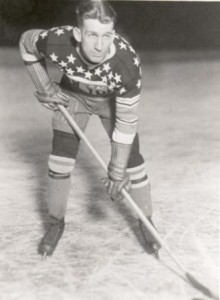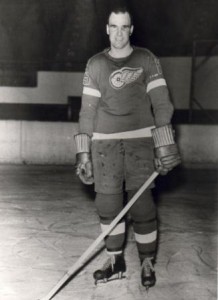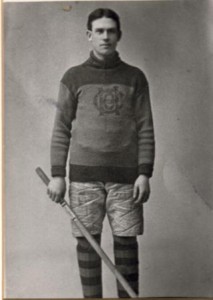 They called him the “Hockey Traveler” and for a very good reason. During the twenty-one years of his active career as an amateur and professional he performed for no fewer than fourteen teams in six leagues including thee
They called him the “Hockey Traveler” and for a very good reason. During the twenty-one years of his active career as an amateur and professional he performed for no fewer than fourteen teams in six leagues including thee
seasons in the National Hockey League with the old New York Americans.
He was one of the fastest skaters ever turned out of this hockey town of Collingwood. He was 130-pound, five-foot-six, fifteen year-old little rabbit had a tough time making the 1921 Collingwood Junior team, perhaps the greatest junior club to represent Collingwood in O.H.A. competition. That was the year that the
Collingwood Bees almost knocked off the famous Stratford Midget, led by Howie
Morenz. They must have been good. Four members of that team Burmister, Bern
Brophy, Artie Clark and Clyde Dey went on to pro careers.
Roy starred for two more years with Collingwood junior and intermediate teams, went to the Owen Sound Greys in 1925, to Niagara Falls under the late Gene Fraser in the senior ranks in 1926 and that same season Niagara Falls became pat of the newly formed pro International League. He signed for eight hundred dollars and a job.
The New York Americans took him up to the big time from New Havens in 1929 and for the next three years he drew down N.H.L. pay while shuffling between the
Americans and New Haven.
It was a pretty good financial situation for Roy, as he beat a path between New
Haven and New York, but the shuttle service arrangement cost him a couple of
Americans League scoring championships. It seemed that every time he got up
there in the American League scoring lead, the Amerks ran into injuries and
back to the Madison Square Garden went Burmister.
In the succeeding years he played for Boston of the Americans League, London and Windsor in the International, back to the Americans loop with Philadelphia, Galt in the old Ontario pro league, two championship years with St. Louis in 1935 and
1936, then to St. Paul and finally closing off his career with Kansas City.
He came back to the amateur ranks in 1941 and played for Collingwood in the O.H.A.
Senior “B” series. So after two decades and over a thousands hockey games, Roy
finally called it quits.
How many goals did he score in that time? We will never know. Roy never kept track of them and it would take a team of researchers to go back over the books in six leagues.


